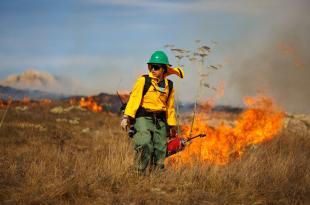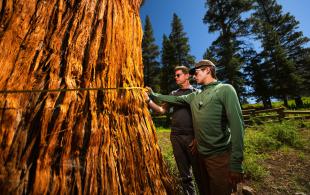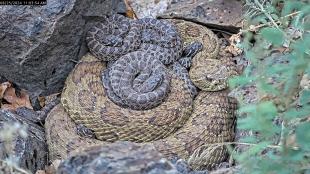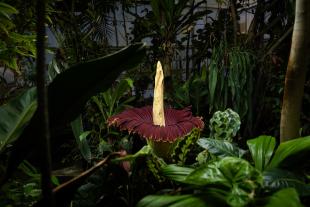'A Once-In-A-Lifetime Experience.' Corpse Flower Bloom Creates Learning Opportunity for Students and Community
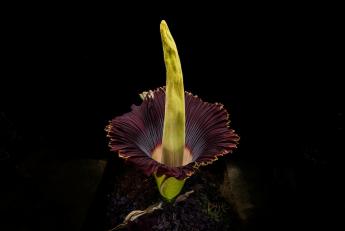
When a six-year-old corpse plant in the Cal Poly greenhouses shot up a green cone this summer, no one expected anything exciting. Other corpse plants housed at Cal Poly had produced similar cones in the past, and they usually grew into leaves.
But one day, Gage Willey, the curator of the Cal Poly Plant Conservatory, checked on the little cone and noticed something unique. The cone had developed enough to tell that it would blossom into a flower.
“When I saw that it was a flower, I yelled. I was so ecstatic,” Willey said. “All I could think is that this is actually happening, I get to be there firsthand and share it with our community; it’s going to be so wonderful. After that, it was off to the races.”

The corpse flower, also known as titan arum, Amorphophallus titanum, is native to the island of Sumatra. The plant makes the world’s largest unbranched inflorescence (cluster of flowers), but flowering is rare. The bloom can grow to more than 8 feet in height and over 3 feet in diameter.
When it flowers, the plant makes a huge stinky maroon funnel, called the spathe, with tiny flowers borne on a huge spike, which is called the spadix. The spathe sends a foul aroma into the still forest air for 24 hours to attract pollinators, then closes up.
This particular corpse plant was donated to and is cared for by the College of Agriculture, Food and Environmental Sciences Horticulture Unit.
Jenn Yost, an associate professor in Biological Sciences and director of the Robert F. Hoover Herbarium, and Matt Ritter, the director of the Cal Poly Plant Conservatory and professor in Biological Sciences, leapt into action, drawing up a plan for the community to safely interact with the flower in a hands-on, intimate way.
“Cal Poly is a place that teaches students not only how to grow plants but to tell other people about plants and interpret things,” Ritter said. “An important part of the conservatory is firing people up about plants.”
Because corpse flowers are so rare, no one was quite sure when the plant, nicknamed Musty, would bloom. The College of Science and Math set up a livestream for the community to watch the plant in real time, as the faculty and students involved in Musty’s care watched it closely.
On the afternoon of July 9, Annie Meeder, a fourth-year environmental management and protection major, was watching the livestream when she noticed that Musty was starting to open up.
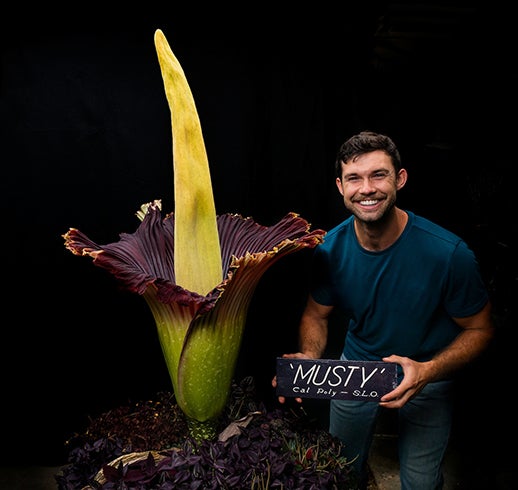
“It felt like my entire body was shot with adrenaline,” Meeder said. She jumped into her car and raced over to the greenhouses to see the flower, where she was drawn into a group of student volunteers.
The team of faculty and students put their pandemic-appropriate plan into action, asking community members to wear masks and form a socially-distanced line, and only allowing one household in to see the plant at a time. But soon they noticed the line stretching longer and longer as people waited upwards of an hour to see the plant.
To take people’s minds off the long wait, and maximize the educational opportunity, the students mobilized, carrying plants from the conservatory out to the line.
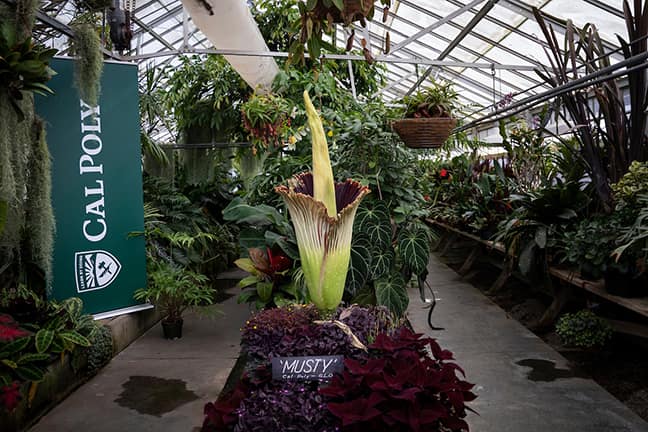
“We wanted to keep people excited and happy, and we got the idea to keep them entertained,” said Jarene Brown, the conservatory’s head student curator. The students talked to community members about the different plants they were holding, such as carnivorous plants or calla lilies, which are related to corpse flowers.
“We kept saying this is like waiting for a ride at Disneyland,” Meeder said. “My professors turned this into an incredible educational opportunity and an opportunity for students to express what they know and what they’ve learned to the public.”
Brown, a fourth-year crop science major, said she loved being able to teach so many people about plants — more than 3,000 people visited the corpse flower while it was blooming— and get people excited about them, too.
“Even though COVID’s going on, we were still able to come together and find a way for people to come interact with this plant,” Brown said. “We made it a really intimate experience by allowing people to take pictures and touch it and smell it. We allowed people to get in there and learn about this thing, even in a complicated situation.”
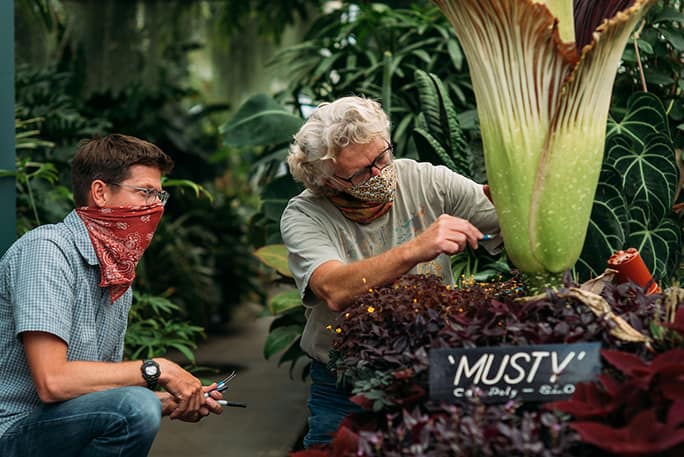
Kieran Althaus, a Cal Poly alum and incoming graduate student in Biological Sciences, said the experience of helping volunteer during the bloom made him feel like a true professional.
“I felt like a community botanist. I felt like someone who knew about plants and could teach other people, and challenge their conceptions of what a flower or a leaf is,” Althaus said. “The experience gave us a feeling of real expertise and professionalism. We got to show the community the cool plants we interact with and study every day. I felt super lucky we got to show people this plant during the pandemic.”
Yost said the bloom was a valuable opportunity for the students as well as a unique experience for everyone who saw the flower.
“If this had bloomed at a botanical garden, you’d pay $20 to $30 to see it and you usually can’t get that close to it,” Yost said. “This whole experience felt very Cal Poly to me. We’re a public university and the public was invited. You could touch the flower and put your face in it, and the students had unprecedented access to run the whole show.”
“It was for sure a Learn by Doing experience,” Brown said. “There was no book or video that told us how to handle what was going to happen. We took it as it came. It’s a once-in-a-lifetime experience and I got to experience it up close.”

